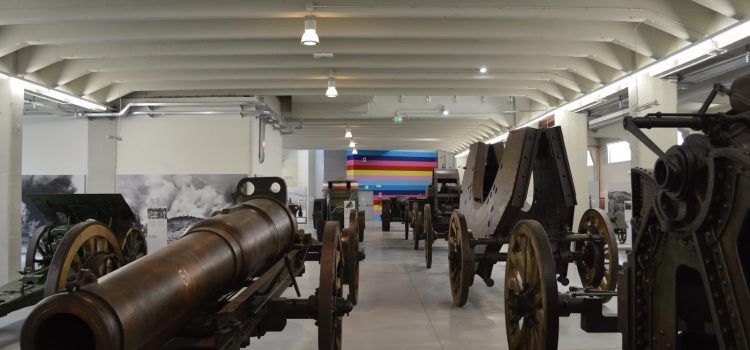Il museo De Henriquez rappresenta una delle maggiori attrazioni museali italiane nel settore . Il messaggio consegnato alla storia dal suo fondatore è una lettera H che riprende l’iniziale del cognome, ed è attraversata da una fascia di colori brillanti, che alludono alla bandiera della pace. La collezione de Henriquez, dal 1983 proprietà del Comune, esposta all’interno del museo, è composta da:15.000 oggetti inventariati, di cui 2800 armi, 24.000 fotografie, 287 diari (38.000 pagine), 12.000 libri, 2600 tra manifesti e volantini, 500 stampe, 470 carte geografiche e topografiche, 30 fondi archivistici, 290 documenti musicali, 150 quadri, un fondo di pellicole (250 documenti cinematografici conservati all’Istituto Luce di Roma), e documenti relativi sia alla prima che alla seconda guerra mondiale oltre che alcuni pezzi unici e straordinari.
L’esposizione permanente dal titolo “1914-1918 Il Funerale della Pace” è dedicata alla storia del Primo conflitto mondiale e parte dal Carro funebre della ditta Zimolo di Trieste (inizi ‘900), dello stesso tipo di quelli che il 2 luglio 1914 trasportarono la salma dell’arciduca Francesco Ferdinando, nipote dell’imperatore Francesco Giuseppe I ed erede del trono degli Asburgo, e quella della moglie duchessa Sofia Chotek dalla Piazza Grande (ora Unità) alla Stazione meridionale di Trieste.
Larga parte dello spazio è attribuito alle grandi bocche da fuoco e ai mezzi ruotati relativi al periodo e corredati da testi esplicativi. Un percorso ricco di storia attraverso le sezioni dedicate alla Propaganda, alla Trincea, alla Guerra industriale, fino ad arrivare al comparti della disfatta di Caporetto, dove è illustrata una delle pagine più tristi della storia italiana, e del L’ultimo fronte dove sono raccontate le fasi finali del conflitto. Un’interessante parentesi su “1914-1918 Trieste in guerra” delinea la storia e le sorti della città dal periodo immediatamente precedente alla conflagrazione fino alla fine della guerra.
Contiene la più grande collezione di armi piccole,medie e grandi d’Italia.
Diego de Henriquez nacque a Trieste il 20 febbraio 1909, fin da giovane si dedicò con passione al collezionismo di oggetti della natura più varia, ma l’inizio della grande collezione bellica cominciò nel 1941,quando richiamato alle armi fu autorizzato dai superiori a recuperare “preda bellica”. Iniziò ad allestire un Museo di guerra, contemporaneamente diede vita a un Giornale del XXV Settore, compilò una guida relativa allo stesso Settore e predispose un laboratorio fotografico. Dopo il 1945,essendo un abile diplomatico, riuscì con le autorità delle diverse truppe di occupazione nel territorio, ad ottenere altro materiale militare che incrementò la sua già ampia collezione.





